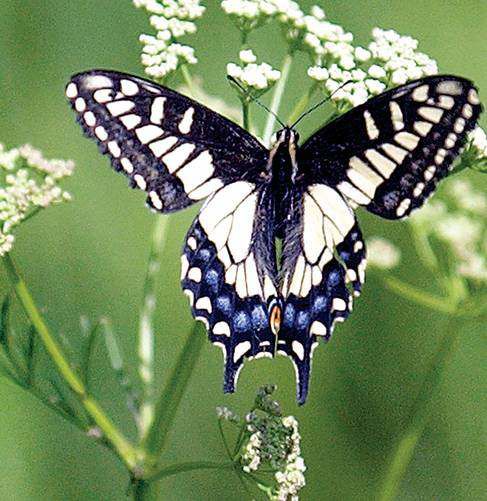Butterflies in Central Oregon
Published 5:00 am Friday, May 23, 2008

- A Milbert’s tortoiseshell butterfly identified by Bill Neill in the Ochocos.
Bill Neill doesn’t miss very often.
Sometimes it’s as simple as a forehand to the baseline with both feet firmly planted on the ground. Other times he resembles a ballerina with a butterfly net, running and jumping and pirouetting across the meadow like Nureyev with a daypack.
Either way, the result’s the same.
He grasps the net about midway up with his free hand, choking off the only avenue of escape. Resting the long handle on the ground, he smooths the creases from the fine mesh, gently pinning his prey between the folds of fabric.
This time around it’s a checkered skipper, more like a moth really, especially if your preconceived notions run to the bold and dramatic. This little black and white arthropod is certainly no bright-winged swallowtail or fluttering fritillary.
But the morning is young and dew still clings to the yarrow. Neill, the guy who wrote the book on Oregon’s butterflies, is beaming with understated optimism.
“It’s still a little cool,” he said, opening the net and sending his erstwhile captive flapping away on the breeze.
Neill is reveling in his element, up to his knees in grass looking out over an Ochoco wildflower meadow in full dress. The boggy soil squishes underfoot, the sun is beginning to slice through the high-elevation chill, and the butterflies are shaking off their frost-induced lethargy.
And Neill is telling us what he knows. Which comes out in precisely articulated bursts of information pithy enough to keep it interesting, basic enough to keep the factoids from fluttering out over our heads.
Butterflies, for instance, are cold-blooded. Their muscles work best at between 80 and 100 degrees; they’re sluggish and make for easy prey at lower temperatures. That’s why they usually hunker down, wings folded and practically invisible, when the temperature drops.
What preys on butterflies?
“Everything,” Neill said.
More than 10,000 species of butterflies exist on Earth, of which about 170 have been found in Washington and Oregon. They range from small, nondescript species to lumbering beauties with intricately detailed wings.
But nothing about the butterfly is as perfectly elaborate as its life cycle.
According to Neill, butterflies lay their pinhead-sized eggs on a specific plant. After a time, the embryo matures and chews its way out of the eggshell as an infant caterpillar. The caterpillar grows and, when it’s ready, attaches itself to a stem or rock, sheds its outer covering and becomes a compact pupa. The pupa sits motionless for as little as a few weeks (depending on the species) and then erupts into the open world.
As a butterfly, as improbable as that may seem. The adults typically live a few weeks during the warm season, extracting nectar from their specific host plant, sipping water in muddy spots, mating and laying eggs. Most don’t make it all the way through. They run the gauntlet of freezing temperatures, drowning, starvation, infection and predation, Neill said. Ants, hornets, ambush bugs, spiders, lizards, birds and mice all appreciate a juicy butterfly for breakfast.
Despite the perils, you get to the right place and you just might see a profusion of butterflies. Neill’s favorite butterfly haunts are in the Ochocos to the east and along the Metolius River to the west.
This particular morning, conditions make for a mixed bag. When the sun streams through, butterflies appear out of nowhere, basking on leaves, extracting nectar from flowers, courting on the wing, chasing off unwanted interlopers. But then the clouds scud by and the butterflies hunker down.
In several meadows across the Ochocos, we see sulfurs and blues, fritillaries and checkerspots. But when the sun goes away and the temperature drops, we’re left stomping around aimlessly, looking for phantoms.
And we get to find out what brought Neill to this greenbelt in the mountains with a butterfly net in his hand.
It started when Neill, now in his 70s, was a child in suburban New York.
“I usually had a box full of something alive in my bedroom,” he said.
At age 10, with the encouragement of his father, Neill bought a book on insects and began collecting butterflies in vacant lots near his home. But he got sidetracked as a teenager and didn’t think much about butterflies again until he moved to Oregon in 1963, a young cardiologist with a family and a rekindled love of the outdoors.
“When I went out it was usually with a butterfly net,” he recalled. “It gave my interest in the out of doors a focus. It could have been something else.”
But then we wouldn’t have “The Guide to Butterflies of Oregon and Washington,” a glossy softcover text that Neill saw published in 2001. In “Butterflies,” Neill melds his scientist’s eye for detail with his passion for the subject.
Recently, Neill’s come full circle, capturing the insects and observing them in his Portland-area home.
“What I find I’m doing now is a lot more of rearing them,” he said. “I’m able to learn a whole lot more about what they do in nature.”
Just then, the sun reappears, the breeze lets up and Neill spots movement out of the corner of his eye.
He dodges to the right, does a little arabesque and soon we’re gathered around, trying to determine whether these antennae have knobs on the end or if this is just a common moth.






